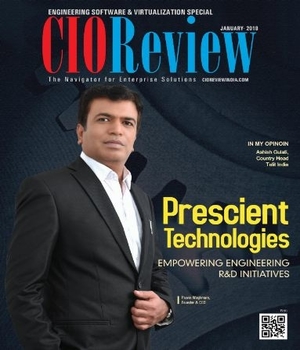
Exploring Virtualization Once Again
Jignesh Vania, Head - Infrastructure & Automation at Adani Ports & SEZ Ltd. | Wednesday, 27 December 2017, 05:23 IST
 We were the first wave adopters of virtualization technologies and the leading VM provider has been our choice for standardized virtualization platform across the platform. We had evaluated other proprietary and opensource platforms at that point in time but found them behind on the maturity curve of the new technology.
We were the first wave adopters of virtualization technologies and the leading VM provider has been our choice for standardized virtualization platform across the platform. We had evaluated other proprietary and opensource platforms at that point in time but found them behind on the maturity curve of the new technology.
Today virtualization is a mature technology platform and though market leader still maintains the lead, other products have caught up on functionality and stability with mature standards. In line with the nature of our business, we have a geographically and functionally distributed architecture across our Ports and Cargo Terminals. We are standardized on Unix for Database tier and Linux / Windows for application and web tiers. Maintaining the leading proprietary virtualization platform across the large installation was becoming unwieldy and expensive. While the premium on stability meant that we were hardly using the cutting-edge feature list that we were buying. While putting up infrastructure for our latest port, we decided it was time to look at other solutions once again after almost a decade, as other alternatives have matured.
We picked up a couple of proprietary and a couple of opensource solutions. The objective criteria we set for ourselves were:
1. Ease of deployment & maintenance: We have an outsourced IT services model and we were paying both for deployment and maintenance with skilled people even scarcer at remote port locations. Our workloads were standardized across 2 – 3 platforms and we looked at templatized deployment. Direct support from vendor was also a key criterion as we had experienced the value of deep expertise at crunch times and knew that it is not feasible for service providers to invest in the same. This was one of the reasons we had decided to stay away from opensource in our previous evaluation.
2. Long term vendor stability: Stability is at a premium and so we were clear that we would look at top 2-3 vendors who have demonstrated long term commitment and development roadmap for the platform. Since we had deep executive level connect with most of the leading contenders their engagement with and commitment to our organization pre-sales and after-sales was considered but wasn’t a differentiator.
3. Feature Set: This time round instead of decided not to focus on functionality criteria based on what is latest available, we went to drawing board, put together what all is on offer and picked out what was of significant relevance in our specific environment. It was a pleasant surprise that technology had matured to the extent that almost all the selected platforms could meet 90% plus requirements on feature set. High availability, Reliability and quick response to anomalous situations were of high value and we focused on these. Ease of management on remotely deployed installations was also of significant in our environment and we looked at the management tool set at micro level. Ability to monitor performance & compliance, enforce policies and analytics capabilities were drilled down upon. Though we did not want to focus on the cutting edge, we did explore the compatibility with Cloud & Hybrid deployments and machine learning based management tool sets from third party vendors.
4. Ownership costs: Though it wasn’t a primary objective as we take reducing costs as imperative rather than an initiative. We keep looking at optimizing costs all the time whether a technology choice is on the table or not. Hence though not stated, it was a background process that ran through the evaluation process. We figured the costs of acquisition, support, services and migration, if any.
Most of us were expecting as a hypothesis that we’ll end up endorsing our current choice but were slightly taken aback with the writing on the wall at the end of the process. The process threw up a solution that we had not even considered in our previous evaluation but this time round it came across as a great balance between tradeoffs viz. proprietary or opensource, market leadership & functionality or costs, good enough now or adoption of futuristic technologies.
The solution we chose is an opensource solution but supported by an enterprise vendor. It has the feature set that take care of our requirement and at the same time is close to that of market leader. It supports hybrid deployments on-premise and on cloud with a sophisticated management tool set that supports advanced analytics. It scored particularly well on high availability, ease of deployment and management.
But with stability at a premium in our environment we decided against a wholesale migration but chose the platform for the newer port and all newer deployments and plan to migrate gradually over a 3-year period as we get more familiar and see the newer solution see us through some crunch scenarios. We’ve already rolled out and have experienced the ease and low cost of deployment. But we would still wait and watch before we turn our evaluation to a conviction.
It would be pertinent to note that we did look at Container technology solutions as a replacement to virtualization, both proprietary and opensource but decided to stick with virtualization for now. But to test waters we are working on using it in conjunction with virtualization for some of the peripheral applications that we are deploying. It does have the potential of delivering significant improvement in areas of resources and speed compared to virtualization as it matures on security and management. Maybe it will be the surprise when we do our next evaluation few years down the line.
CIO Viewpoint
Digital Transformation In Manufacturing
By Jacob Peter, Head IT, Bosch Engineering and Business Solutions
When Technology Meets the World of Financial...
By Vamsi Krishna Ithamraju, Group IT Head, CreditAccess Asia
By Daljit Singh Sodhi, Associate Director-IT at KPMG India
CXO Insights
4 Steps to Lean in Industry 4.0
By Joe Panebianco, Director of Manufacturing Engineering, Tekni-Plex, Inc.
Standing at the Crossroad of Lean Manufacturing...






